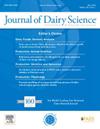Surface proteins of Bifidobacterium bifidum DNG6 growing in 2′-fucosyllactose alleviating lipopolysaccharide-induced intestinal barrier injury in vitro
IF 3.7
1区 农林科学
Q1 AGRICULTURE, DAIRY & ANIMAL SCIENCE
引用次数: 0
Abstract
Human milk oligosaccharides promote the growth and adhesion of Bifidobacteria, thus exerting multiple biological functions on intestinal epithelial cells. Bacterial surface proteins play an important role in bacterial–host intestinal epithelial interactions. In this study, we aimed to investigate the effects of surface proteins extracted from Bifidobacterium bifidum DNG6 (B. bifidum DNG6) consuming 2′-fucosyllactose (2′-FL) on Caco-2 cells monolayer barrier injury induced by lipopolysaccharide, compared with lactose and galacto-oligosaccharides. Our results indicated that 2′-FL may promote the surface proteins of B. bifidum DNG6 to improve intestinal barrier injury by positively regulating the NF-κB signaling pathway, reducing inflammation (TNF-α reduced by 50.34%, IL-6 reduced by 22.83%, IL-1β reduced by 37.91%, and IL-10 increased by 63.47%) and strengthening tight junction proteins (ZO,1 2.39×; claudin,1 2.79×; and occluding, 4.70×). The findings of this study indicate that 2′-FL can further regulate intestinal barrier damage by promoting the alteration of B. bifidum DNG6 surface proteins. The findings of this research will also provide theoretical support for the development of synbiotic formulations.
在 2'-FL 中生长的双歧杆菌 DNG6 表面蛋白减轻 LPS 引起的体外肠屏障损伤
人乳寡糖(HMOs)能促进双歧杆菌的生长和粘附,从而对肠上皮细胞发挥多种生物学功能。细菌表面蛋白在细菌-宿主肠上皮细胞相互作用中发挥着重要作用。本研究旨在研究从双歧杆菌 DNG6(B. bifidum DNG6)中提取的表面蛋白消耗 2'-fucosyllactose (2'-FL) 与乳糖 (Lac) 和半乳寡糖 (GOS) 相比,对脂多糖诱导的 Caco-2 细胞单层屏障损伤的影响。我们的研究结果表明,2'-FL 可促进双歧杆菌 DNG6 的表面蛋白改善肠道屏障损伤,通过正向调节 NF-κB 信号通路,降低炎症反应(TNF-α 降低 50.34%,IL-6 降低 22.83%,IL-1β 降低 37.91%,IL-10 提高 63.47%)和增强紧密连接(ZO-1 2.39 倍,Claudin-1 2.79 倍,Occludin 4.70 倍)。本研究结果表明,2'-FL 可通过促进双歧杆菌 DNG6 表面蛋白的改变,进一步调节肠屏障损伤。这一研究结果也将为合成益生菌配方的开发提供理论支持。
本文章由计算机程序翻译,如有差异,请以英文原文为准。
求助全文
约1分钟内获得全文
求助全文
来源期刊

Journal of Dairy Science
农林科学-奶制品与动物科学
CiteScore
7.90
自引率
17.10%
发文量
784
审稿时长
4.2 months
期刊介绍:
The official journal of the American Dairy Science Association®, Journal of Dairy Science® (JDS) is the leading peer-reviewed general dairy research journal in the world. JDS readers represent education, industry, and government agencies in more than 70 countries with interests in biochemistry, breeding, economics, engineering, environment, food science, genetics, microbiology, nutrition, pathology, physiology, processing, public health, quality assurance, and sanitation.
 求助内容:
求助内容: 应助结果提醒方式:
应助结果提醒方式:


